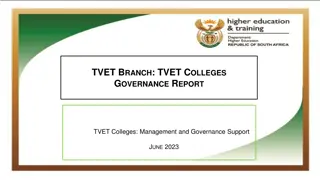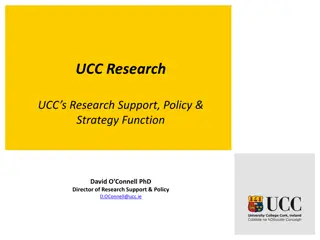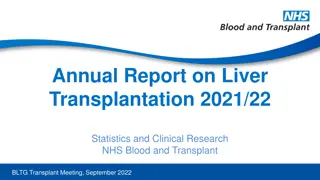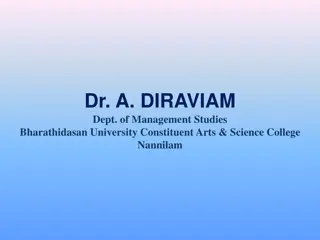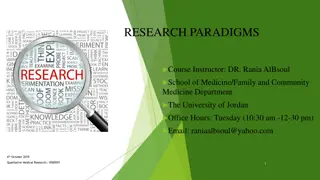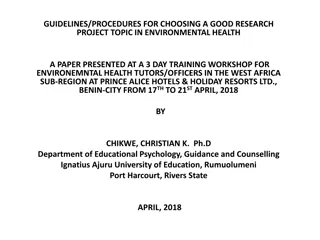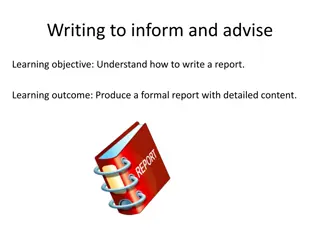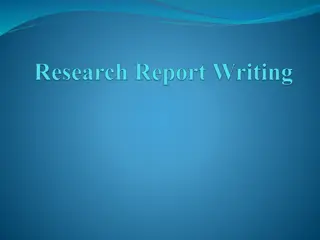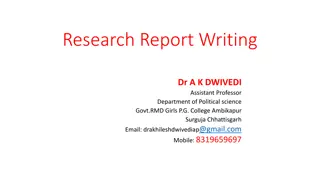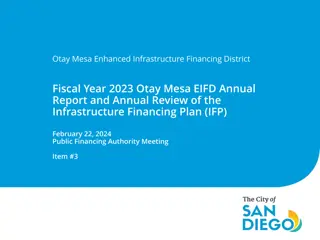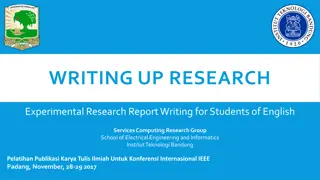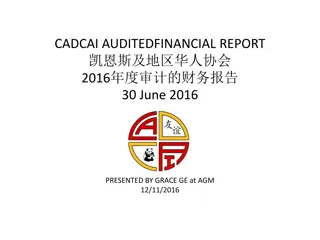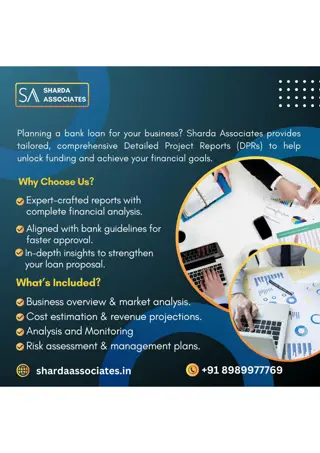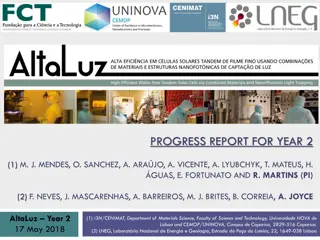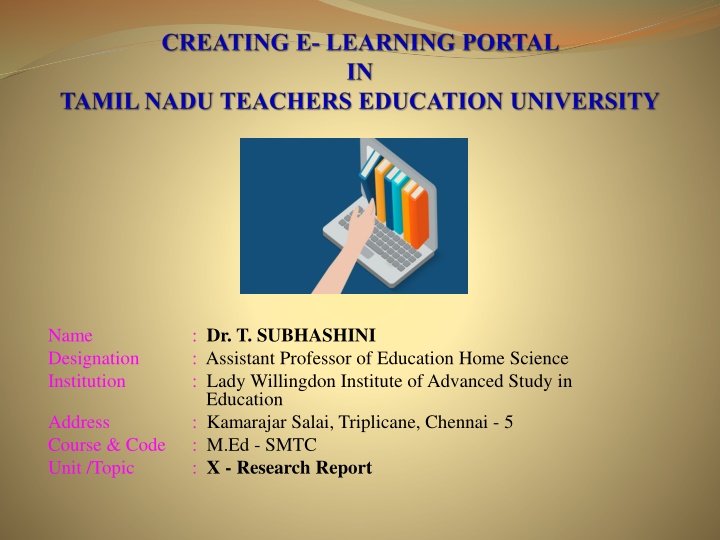
Writing a Comprehensive Research Report
Learn the guidelines for writing a research report effectively, from structuring the content to presenting findings objectively. Understand the importance of clear language and concise presentation in conveying research outcomes accurately.
Download Presentation

Please find below an Image/Link to download the presentation.
The content on the website is provided AS IS for your information and personal use only. It may not be sold, licensed, or shared on other websites without obtaining consent from the author. If you encounter any issues during the download, it is possible that the publisher has removed the file from their server.
You are allowed to download the files provided on this website for personal or commercial use, subject to the condition that they are used lawfully. All files are the property of their respective owners.
The content on the website is provided AS IS for your information and personal use only. It may not be sold, licensed, or shared on other websites without obtaining consent from the author.
E N D
Presentation Transcript
: Dr. T. SUBHASHINI : Assistant Professor of Education Home Science : Lady Willingdon Institute of Advanced Study in Education : Kamarajar Salai, Triplicane, Chennai - 5 : M.Ed - SMTC : X - Research Report Name Designation Institution Address Course & Code Unit /Topic
RESEARCH REPORT Contents Meaning of research report Writing of research report Format of research report Title Page Introduction Review of Literature Methodology Analysis and Interpretation Discussion and Conclusion References and Appendices
Report A report is a written document that is short, sharp and specially written for a particular audience and purpose. Report Writing is the creation of a structured document that precisely describes and examines an event or occurrence. Research Report is a reliable source to recount details about a conducted research and is most often considered to be a true testimony of all the work done to garner specificities of research.
Guidelines for Writing the research report Develop your thinking. Divide your narrations into paragraphing and use informative headlines. Use present tense and active voice. Minimize the use of technical language. Use visual aids. Be objective. Treat data confidentially. Revise and rewrite. Clear and Concise
Writing of Research report The research report should be written in a clear and unambiguous language so that the reader can also objectively judge the adequacy and the validity of the research. Hence the purpose of writing a research report is to know, *. what has been done? *. why it was done ? *. what results were obtained? *. what the conclusions reached?
Format of a research report Research Report 1. Title Page 7. Appendix 6. References 2. Introduction 5. Discussion Title 3. Method Acknowledgements Support and Non support of Hypotheses 4. Results Problem Tables and Figures Implications Review Literature Design Statistical Presentation Rationale Procedure Conclusions
Title Page of the report Title page contains the following information The name of the topic The name of the author The name of the institution The name of the candidate Year of submission Course of degree. The title should be concise. Clearly specify the purpose and scope. Typed in capital letters. Centered on the page. Avoid word or page split.
Example LEARNING STYLE AND PARENTING INVOLVEMENT IN RELATION TO ACADEMIC ACHIEVEMENT Thesis submitted in partial fulfillment for the degree of MASTER OF EDUCATION REG. NO: MED 1412020 TAMIL NADU TEACHERS EDUCATION UNIVERSITY KARAPAKKAM CHENNAI MAY 2019
Acknowledgement It should, recognizes the person to whom the writer is thankful for guidance. clearly specify the names. be precise and short. sincerely recognize the institutions for providing academic guidance, administrative support and facilities. Example My sincere thanks to our Principal for the moral support and encouragement. I also extent my thanks to our Institution for providing academic support. I acknowledge my sincere gratitude to my guide for the valuable guidance and supervision.
Table of Content It is known as structure of the report, organization of the report, and divisions of the report. The introduction. The chapters with subsections Example The bibliography. S.NO CONTENT PAGE The appendix. NO. Page numbers. 1.0 Introduction The Problem 1 Acknowledgement. 1.1 Definition of the Variables 6 List of tables. 1.2 Objectives of the Study 10 1.3 Limitations of the Study 16 List of figures.
List of Tables and Figures Here, the details of tables and figures should be given in chronological orders. Its sole purpose is to inform readers about where the tables or figures appear in the report. Example 1 S.NO 3.1 3.2 LIST OF FIGURES Distribution of the Samples Mean and Standard of the Variables PAGE.NO 82 84 Example 2 S. NO LIST OF FIGURES Pie diagrams percentage according to personal variables PAGE.NO 3.1 showing 83
Body of the report The main body of the report contains five logical divisions: 1. The introduction. 2. Review of related literature. 3. Design of the study. 4. Analysis and interpretation of the data. 5. Summary and conclusion. 1. Introduction A good introduction has following components, It should be lucid, complete and concise. Researcher defines, analyses and state the nature of the problem with research objectives. It includes the significance of the problem and need for undertaking the research. Research variables and terms should be properly defined and investigated
2. Review of Literature The review of literature involves the systematic identification, location and analysis of documents containing information related to the research problem. Objectives of review of literature a. Identifying variables relevant for research b. Avoidance of repetition c. Synthesis of prior works d. Determining meaning and relationship among variables Sources of the Review Journals and Books Indexes Doctoral Dissertations Abstracts E-Portal Articles
Example of Review Literature Barton, M., & Diener, E. (2010). conducted a study on The role of learning styles in second language learning among Distance Education students . The objectives of the study was to find out learning style among distance education students. The sample consisted of 112-English language students of Payame Noor University(PNU), Arabic center, Iran. Memletics questionnaire was used as a tool for the study. The major findings of the study was that the mean scores of listening, writing structure and reading of students with different learning styles differ significantly.
3. Design of the Study This section explains the design of the study and also includes a detailed description about: Method used in the conduct of study. Type of data needed for the study. Nature of population. Procedures for the collection of data. Tools and techniques used for their collection.
3. 1 Research Objectives These are the key elements of the project. They aims to address the research questions or issues pertaining to the project. Objectives should be very concrete and presented in the order of their potential importance. Also reflects theoretical considerations. Statements presenting should be self explanatory. Provide general guidelines for the activities to be included in the project. Example To study the difference between learning style and parental involvement of ninth standard students owing to gender and stream of study.
3.2 Hypotheses A hypothesis is an tentative assumption It has to be verified with proper statistical techniques . Example There is no significant difference in learning style and parental involvement with respect to gender and stream of study ninth standard students . 3.3 Sampling A sample is any number of persons selected to represent the population The size of sample and the method of sampling is vital to analyze the data effectively. Example The total sample selected for the study was 200 special students and purposive sampling techniques was adopted.
3.4 Data Analysis Qualitative data analysis is the range of processes and procedures using non numerical data whereby collected qualitative data analyzed by using explanation, understanding, interpretation of the people and situations. Example Content analysis, thematic observations. Quantitative data analysis is the range of processes and procedures using numerical data whereby collected data analyzed by using various statistical techniques namely categories of measurement scale, cross tabulation, factor analysis, trend analysis. Example Descriptive analysis, differential analysis, correlation analysis. explicitation, analyzsis, recording
3.5 Method of testing Hypotheses Mean score, level of significance, probability value, difference between mean scores, z-score, t-statistics, ANOVA, chi-square, correlation etc. Example There is no significant relationship between learning style and parental involvement of ninth standard students. (Correlation statistical tools used to verify the above hypothesis)
4. Analysis and interpretation of the data This section is heart or major part of the report. It should present the essential details of the statistical analysis. Description chance or accidental discoveries should be avoided. Reports may be either descriptive or explanatory. The findings should be organized in easiest way for the readers to group them.
Example: Differential analysis - T-test Variable Gender N Mean S.D t value Level of significance Learning Style Boys 107 67.04 13.8 1.79 S Girls 93 71.86 15.5 Form the above, it is found that the t value of learning style between the boys and girls is 1.79. Here the calculated value is lesser than the table value. So the null hypothesis is rejected, that shows there is significant difference in learning style of boys and girls students from ninth standard.
Discussion The data are presented in the table and figures accompanied by textual discussion. Tables which are complex and lengthy should be placed in appendix. In the textual discussion point out important facts and the relationship to give meaning of the data. Summarize and analyze the new information Example There is a significant relationship between learning style and parenting involvement of ninth standard students which is contradictory with Park and Bauer (2007) who found that no significant relationship between learning style and parenting involvement.
4.1 Discussion follows three stages ---- 1. Setting the stage. ---- 2.Presenting the findings and articulation stage. ---- 3. Articulation of findings stage. Stage 1 - Setting stage The readers should be assured that the study is now set for testing the hypothesis and answering various questions. Should contain procedures followed in transforming the information sought into analyzable data. Prepares the ground for data analysis. If it is complicated it requires to be broken into several parts.
Stage 2 - Presenting the findings Basic findings should be stated first and then elaborate the core findings. The reader should be provided with answers for all the research questions. Findings should be elaborated descriptively accompanied with statistical significance. The results should be summarized in prose and statistically. Stage 3 - Articulation and findings The discussion begins with clear and precise statement of the hypothesis raised in the introduction part. Each statement should infer something new for the reader. Interpret the results within the framework of the research objectives. The literature review could be used to substantiate the results.
5. Summary and Conclusion It is the last part of the report. This includes a brief re-statement of the problem, description of the procedures used and discussionof findings and conclusions. The conclusion are presented concisely and related directly to the hypotheses. It reviews all the information that has been presented in previous sections. Conclusions should be logical and not persuasive.
5.1 Recommendations Supported by clear rationale substantiated with all relevant information. Each recommendation should focus on one issue or problem. Each statement should relate to the original objectives of the study. Example The present study can be extended to rural areas. The same study can also be attempted on a large sample size and on different age groups
References/bibliography It is a record of the sources and materials that have been used for the study. Divide the bibliography into subsections for books, for periodicals and journals etc.., They are arranged in alphabetical order. Year of publication, title of the book, place of publication, publishers name should follow the pattern. Example Cetin B, (2015). Academic motivation and self-regulated learning in predicting academic achievement in college students. Journal of International Education Research, 11(2), 95-106.
Appendices All the relevant supporting widely materials are presented here. Copies cover letters of request, printed forms of questionnaires, and tests are placed here. Additional data that are too extensive are included in this section. Example Personal data sheet, Questionnaires, Copy of Permission letter, Photographs and Maps.
Summary Research report is a overview of the research work and reveals the entire work done by the investigator in a systematic approach. Generally the strategies in writing a research report requires unique and standardized format. The investigator layouts a research report to brief all key ideas of the research work. Summarizing the chief elements and contribution should be precise when writing a research report. Further proper way of writing research report should enable the reader to gain knowledge about what already done and also ensure to read the dissertation. Hence it can be concluded that the report of the research ideas is to nurture, Thirst to do Research in Relevant field .
References Best, W. John., and Kahn, V. James. (1996). Research in Education (Seventh Edition). Prentice-Hall of India. Gupta, S. K., and Rangi, P. (2014). Research Methodology: Methods, Tools and Technique. Kalyani publishers. Kothari, C.P. (2014). Research Methodology Methods and Techniques (Third Edition). New Age International Publishers. Mangal, S.K. (1995). Educational Psychology. Prakash Publishers. Mangal, S.K., and Mangal Uma. (2011). Essentials of Educational Technology. PHI. Mohan Radha. (2011). Research Methods in Education. Neelkamal Publications. Nagarajan, K., and Srinivasan, R. (1994). Research Methodology in Education. Ram Publication. Singh, A. K. (1997). Tests, Measurements and Research Methods in Behavioural Sciences. Bharati Bhawan.

